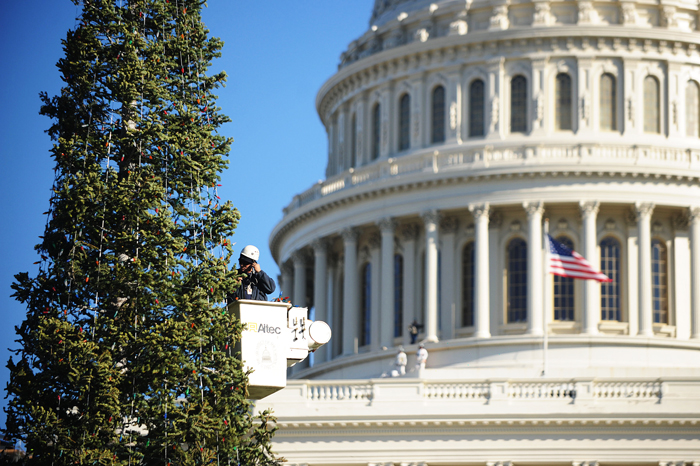WSU research on the way to D.C. in Capitol Christmas tree
The Capitol Christmas tree is installed by workers of the office of the Architect of the Capitol December 1, 2011 in Washington, DC.
November 15, 2013
With the holiday season approaching, the Capitol’s reception of its annual Christmas tree is right around the corner, and this year the Christmas tree is coming from Colville.
“It’s quite an honor to be chosen,” said Gary Chastagner said, a professor of plant pathology at WSU, Puyallup.
Chastagner is the leader of the research team which placed sensors on the 55 foot Engelmann spruce, which is currently traveling to Washington, D.C. The tree, originally from the Colville National Forest, is due to arrive in Flagstaff, Ariz., today.
Placed in strategic positions on the tree are three sensors that monitor the tree’s moisture levels and surrounding temperatures. The sensors aid in keeping the tree in the best possible condition by transmitting information. One sensor is placed at the base, one in the middle, and one toward the top.
“We used existing technologies and traditional techniques,” Chastagner explained.
The Engelmann spruce is enclosed in a metal shell to maintain high humidity in order to aid the tree in retaining as much moisture and vitality. The shell also protects the spruce from wind and any other possible inclement weather. The sensors are utilized to ensure the tree is in good condition and fit to be placed on display.
Two drivers from Colville along with Cally Davidson, a U.S. Forestry technician, are travelling with the tree. Davidson checks in with Chastagner periodically with tree samples and updates.
When Chastagner approached the U.S. Forestry Service about placing sensors within the tree, they were excited to take part in his research.
Chastagner hypothesized that the tree may lose more moisture than in previous years when the tree came from Washington because this year’s route places the tree traveling through southern states such as Arizona, New Mexico and Texas.
However, he is still hopeful for the tree’s healthiness based on previous research on maintaining healthy Christmas trees on a smaller, at-home level. Chastagner’s research focuses on determining if large trees behave similarly to smaller trees.
“We expect a confirmation of (our) previous work and research with smaller trees,” Chastagner said.
The tree is reported to be extremely healthy so far. Samples collected have illustrated that the tree has retained much of the original moisture that it left Colville with.
Jennifer Knutson, the Capitol Christmas tree coordinator, said in previous years the original locations of Christmas trees would differ every year by rotating through national forests and different regions of the United States. Recently however, the process of selection has been on a volunteer basis.
After Chastagner nominated Colville National Forest and was selected, 45 trees were deemed eligible to be chosen. Eventually, the number was narrowed down to eight, and the architect in charge of the project in Washington chose the final tree, Knutson said.
This is not the first time a Washington tree has been chosen. In 2006, the Capitol chose a Pacific Silver Fir tree from the Olympic National Forest in Washington for the year’s festivities, Knutson said.









